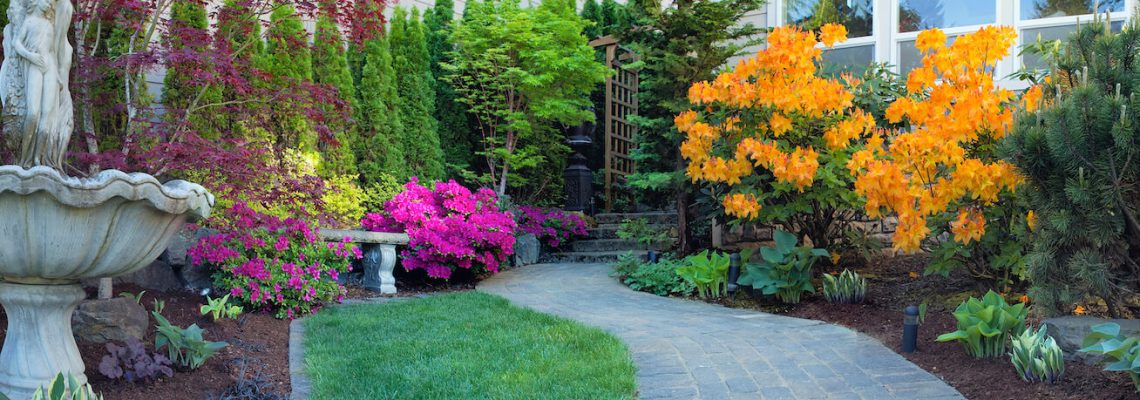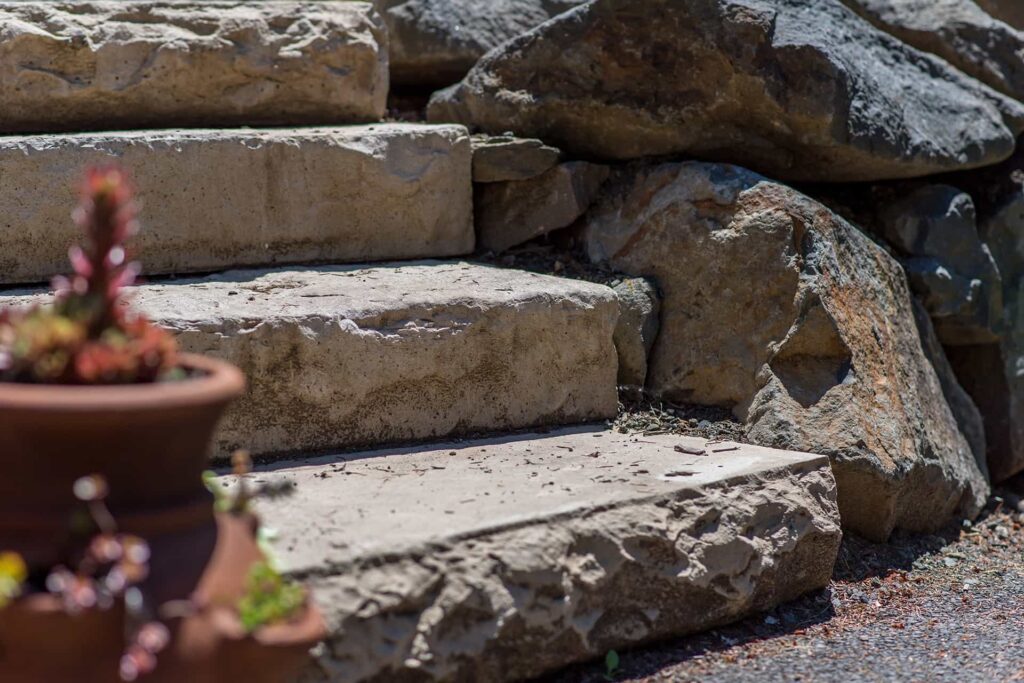When it comes to designing and landscaping your outdoor space, striking the perfect balance between hardscape and softscape elements is essential. Hardscape and softscape are two fundamental components of any well-designed yard, and finding the right equilibrium between them can transform your outdoor area into a harmonious and functional oasis.
In this article, we will explore the concepts of hardscape and softscape, delve into their individual characteristics, and provide tips on how to achieve the ideal balance between them in your yard.
Whether you’re a seasoned gardener or a novice, this guide will help you create a stunning and inviting outdoor environment that suits your style and needs.
Understanding Hardscape and Softscape
To begin, it’s important to define and differentiate hardscape and softscape:
Hardscape refers to the non-living, solid elements in your outdoor space. These include pathways, patios, retaining walls, decks, fences, and any other man-made structures. Hardscape elements are typically constructed using materials like concrete, brick, stone, wood, and metal. They serve both functional and aesthetic purposes, providing structure, organization, and a sense of permanence to your yard.
Softscape, on the other hand, encompasses all the living, horticultural elements in your landscape. This category includes trees, shrubs, flowers, grass, and other plants. Softscape elements add color, texture, and a natural feel to your outdoor space. They are dynamic and ever-changing, requiring maintenance and care to thrive. Softscape features can be used to create privacy, provide shade, or simply enhance the overall appeal of your yard.
Now that we have a clear understanding of hardscape and softscape, let’s explore how to strike the perfect balance between these two elements to create an appealing and functional outdoor environment.
Balancing Hardscape and Softscape: Why It Matters
The balance between hardscape and softscape is crucial for several reasons. Achieving the right mix not only affects the aesthetics of your yard but also influences its functionality, maintenance requirements, and overall enjoyment. Here are some key reasons why finding the right balance matters:
- Aesthetics: The interplay between hardscape and softscape elements is what gives your yard its unique character. A well-balanced combination can create a visually appealing and harmonious outdoor space.
- Functionality: Hardscape elements provide structure and usability to your yard. Paths, patios, and seating areas are essential for entertaining, relaxation, and practicality. Softscape elements offer shade, natural beauty, and a connection to nature. Striking the right balance ensures that your outdoor space is both beautiful and functional.
- Maintenance: Softscape elements, being living things, require regular maintenance, such as watering, pruning, and weeding. Hardscape elements, while not maintenance-free, generally need less attention. The balance you strike can impact the time and effort you need to invest in yard care.
- Climate and Environment: The climate and environment in your region play a significant role in determining the optimal balance between hardscape and softscape. The right balance can help you create a yard that thrives in your specific conditions.
- Personal Preferences: Your own preferences and lifestyle also influence the balance you should aim for. Some people may prefer low-maintenance yards with more hardscape, while others may lean towards lush, green spaces.
With these factors in mind, let’s explore some tips and considerations for achieving the perfect balance between hardscape and softscape in your yard.
Assess Your Needs and Goals
Before diving into any landscaping project, it’s essential to start with a clear understanding of your needs and goals. Ask yourself the following questions:
- How do you intend to use your outdoor space? Is it primarily for entertaining, relaxation, gardening, or a mix of activities?
- What is your preferred style? Do you lean towards a modern, minimalist design or a lush, naturalistic look?
- What is your maintenance capacity? Are you willing to invest time in gardening, or do you prefer a low-maintenance yard?
- What is your budget for landscaping? Hardscape elements can be more costly than softscape elements, so it’s important to consider your financial constraints.
By addressing these questions, you’ll gain clarity on what you want to achieve with your yard and can start to develop a plan that aligns with your preferences and requirements.
Consider Your Climate and Environment
The climate and environment of your region are significant factors in determining the balance between hardscape and softscape. For example:
- In arid or drought-prone areas, you may want to reduce the amount of softscape to conserve water and opt for drought-resistant plants.
- In regions with heavy rainfall, well-constructed hardscape elements like drainage systems and paths become crucial to prevent erosion and water damage.
- In areas with extreme temperatures, hardscape elements can provide a cooler, more stable surface for outdoor activities.
Understanding how your local climate and environment impact your yard will help you make informed decisions about the ratio of hardscape to softscape.
Start with a Focal Point
When planning your landscape design, it’s helpful to start with a focal point. A focal point can be a specific hardscape or softscape feature that draws attention and sets the tone for your yard. Some common focal points include:
- Hardscape Focal Points: A well-designed patio, deck, or pergola can serve as a strong hardscape focal point. These structures can anchor your outdoor space and provide areas for dining, lounging, or entertaining.
- Softscape Focal Points: A stunning garden bed, a mature tree, or a striking flower arrangement can also be a focal point. These natural elements add color, texture, and visual interest to your yard.
By beginning with a focal point, you can build your design around it, ensuring that the balance between hardscape and softscape complements and enhances this central feature.
Create Zones and Pathways
Zoning and pathways are essential for organizing your outdoor space and ensuring that it’s both functional and visually appealing. Zoning involves dividing your yard into specific areas or zones, each serving a distinct purpose. For example:
- Entertainment Zone: This zone may feature a hardscape patio or deck with seating and a grill, perfect for outdoor gatherings and dining.
- Relaxation Zone: Create a tranquil softscape area with comfortable seating, perhaps shaded by a tree or a pergola, where you can unwind and enjoy nature.
- Garden Zone: Dedicate a section of your yard to gardening, where you can grow flowers, vegetables, or other plants that you love.
- Play Zone: If you have children, designate an area for play equipment and open space for games and activities.
Pathways, whether made of stone, gravel, or pavers, connect these zones and guide people through your yard. They not only add a hardscape element but also help maintain the balance by breaking up larger areas of softscape.
Embrace Outdoor Harmony in Design
Striking the perfect balance between hardscape and softscape isn’t just about the quantity of each; it’s also about how they work together in design. Here are some design principles to keep in mind:
- Texture: Combining different textures in both hardscape and softscape elements can add depth and interest to your yard. For instance, juxtapose smooth stone pavers with the lush foliage of groundcovers.
- Color: Consider how the colors of your hardscape and softscape elements complement or contrast with each other. For example, bright flowering plants can pop against a backdrop of neutral-colored hardscape.
- Scale and Proportion: Ensure that the scale of your hardscape elements harmonizes with the scale of your softscape elements. Large trees can complement a spacious patio, while a smaller garden bed may pair well with a narrow path.
- Unity: Create unity in your design by repeating specific elements or materials throughout your yard. This can help tie everything together and create a cohesive look.
Seek Professional Guidance
Landscaping can be a complex and daunting task, especially if you’re aiming for a specific balance between hardscape and softscape. If you’re uncertain about where to start or how to achieve your goals, consider consulting a professional landscape designer and hardscape company. A designer or contractor can offer expertise, creative solutions, and insights tailored to your unique space and preferences.
Professional guidance is particularly valuable if you’re dealing with challenging terrain, drainage issues, or specific aesthetic goals that require expertise beyond your knowledge.
Landscape Maintenance Considerations
The balance between hardscape and softscape also affects the maintenance requirements of your yard. Here are some maintenance considerations to keep in mind:
- Softscape Maintenance: Plants require regular care, including watering, pruning, weeding, and fertilizing. Be prepared to invest time in nurturing your softscape elements, or choose low-maintenance plants if time is a concern.
- Hardscape Maintenance: While hardscape elements generally require less ongoing care than plants, they are not maintenance-free. Periodic cleaning, sealing, and repairs may be necessary to keep your hardscape looking its best.
- Budget for Maintenance: Maintenance costs should be factored into your landscaping budget. Softscape maintenance costs can vary depending on the types of plants you choose, while hardscape maintenance costs may include repairs and cleaning.
Adapt and Evolve
Your yard is not a static creation but an evolving space that can change over time. As plants grow and mature, their maintenance needs may change, and you might need to adjust your hardscape elements accordingly. Additionally, your personal preferences and lifestyle can evolve, prompting you to reevaluate the balance between hardscape and softscape.
Don’t be afraid to make changes and adaptations as needed to keep your yard in line with your current priorities and desires. A well-maintained yard is a dynamic and living space that can bring you joy and relaxation for years to come.
Why You Should Hire a Hardscaping Contractor
While creating a harmonious balance between hardscape and softscape elements in your yard is an exciting DIY project, there are times when seeking professional assistance is not only beneficial but also necessary. Hiring a hardscaping contractor can bring invaluable expertise, access to the best materials, and the assurance of quality craftsmanship to your landscaping project. Professionals can help you navigate complex terrain, drainage issues, and design challenges, ensuring your hardscape elements are structurally sound and aesthetically pleasing. Additionally, they can save you time and effort, allowing you to enjoy your outdoor space sooner. So, whether you’re planning a grand patio, a retaining wall, or intricate walkways, enlisting the services of a hardscaping contractor can make a significant difference in achieving the perfect balance between hardscape and softscape in your yard.
Conclusion
Striking the perfect balance between hardscape and softscape in your yard is a dynamic and personal endeavor. It’s about creating a space that reflects your preferences, suits your needs, and harmonizes with your environment. By assessing your goals, considering your climate, starting with a focal point, and embracing design principles, you can craft an outdoor oasis that is both beautiful and functional.
Remember that achieving this balance is not a one-time task but an ongoing process that may require adjustments as your yard matures and your lifestyle evolves. Whether you’re a gardening enthusiast or a novice, the key to a successful landscape is to find the equilibrium that makes your outdoor space a place of serenity and enjoyment.


